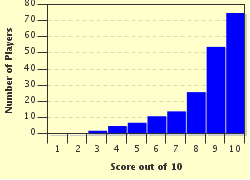Quiz Answer Key and Fun Facts
1. How are new stars born?
2. How long is a star's life-cycle?
3. Not including the Sun, which star is closest to Earth?
4. Which of these is a star that ends its life via a massive explosion?
5. Which of the following stars is classed as a super red giant?
6. Eventually all stars will die. What will happen to the Sun as its life begins to come to an end?
7. When we go outside on a clear night, we can see that the stars make patterns in the sky. What do we call these patterns?
8. Some stars sit so close together that they orbit around each other.
9. What name do we give to a large group of stars orbiting a common center of mass?
10. The sun contains the elements hydrogen and helium.
Source: Author
ElusiveDream
This quiz was reviewed by FunTrivia editor
CellarDoor before going online.
Any errors found in FunTrivia content are routinely corrected through our feedback system.

